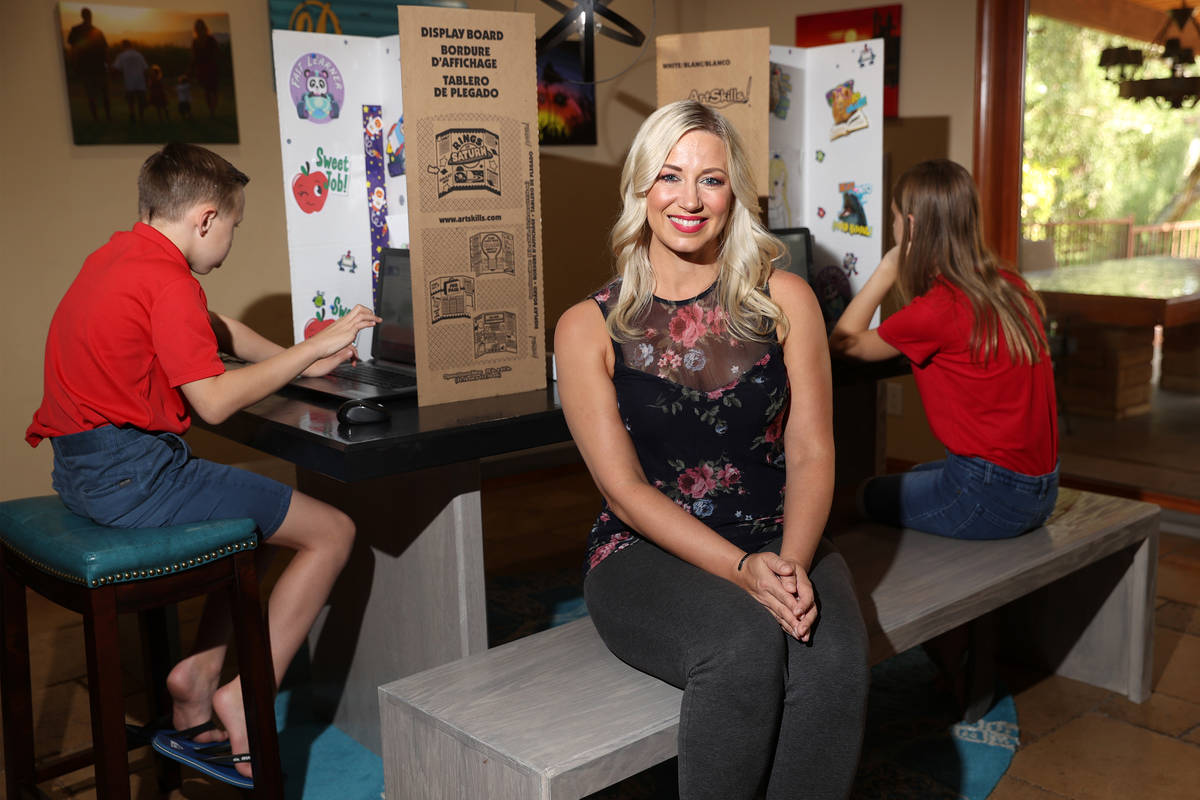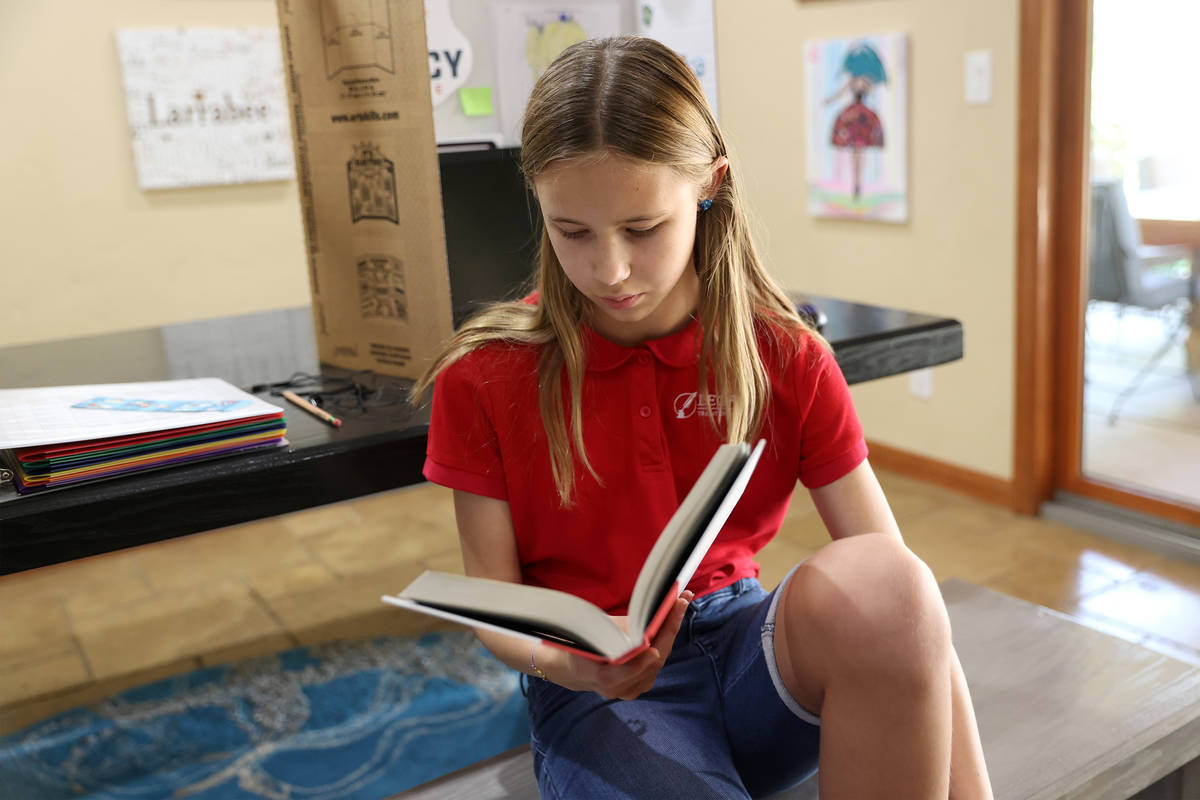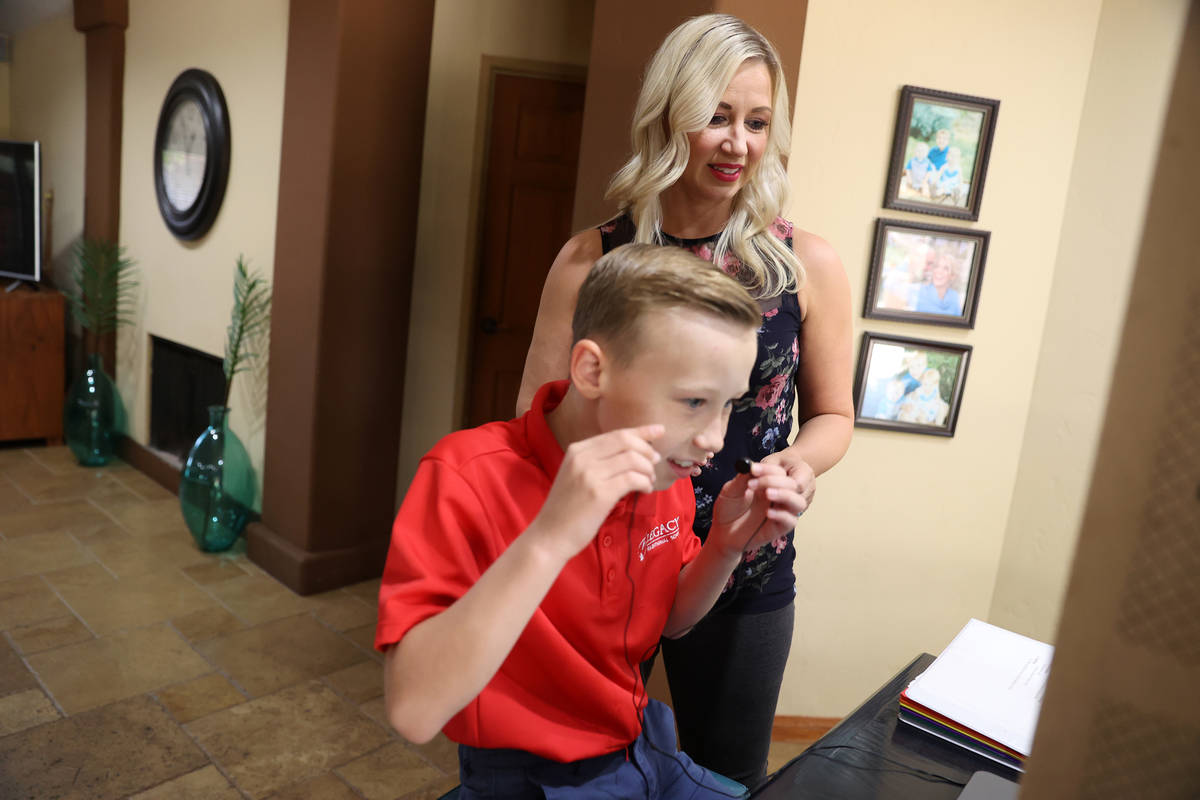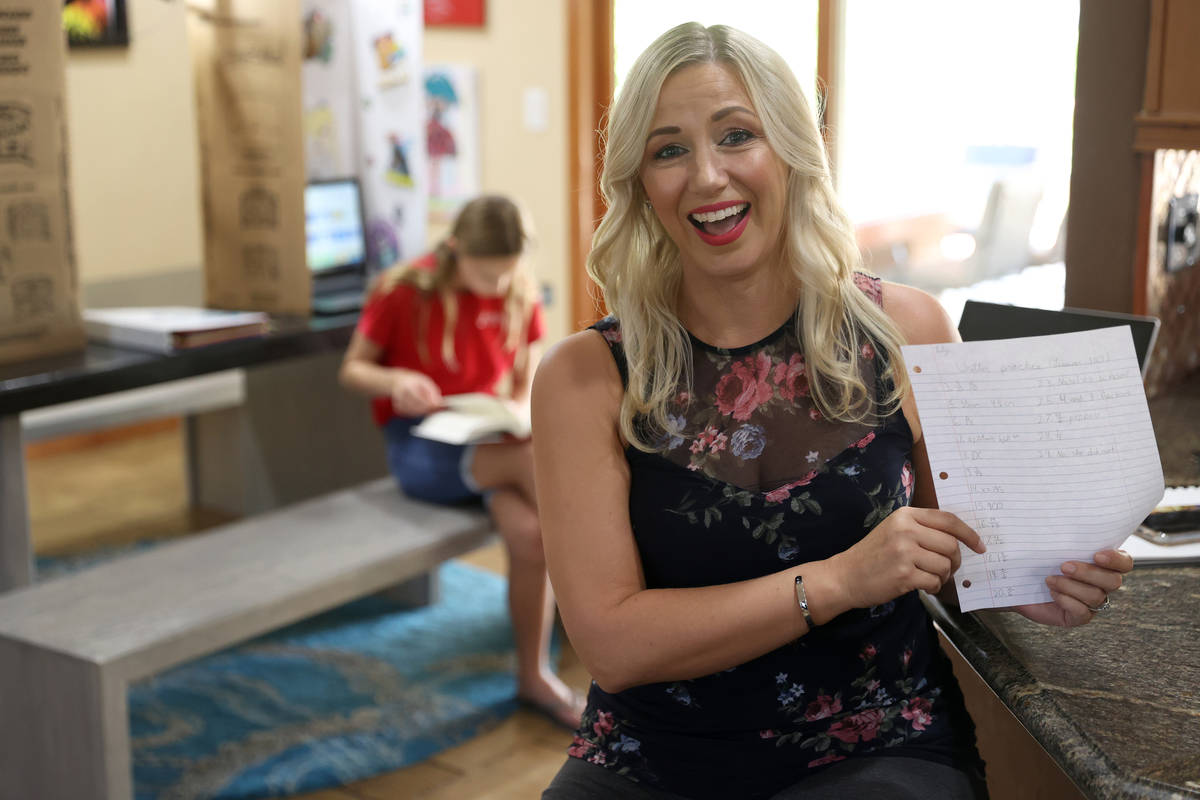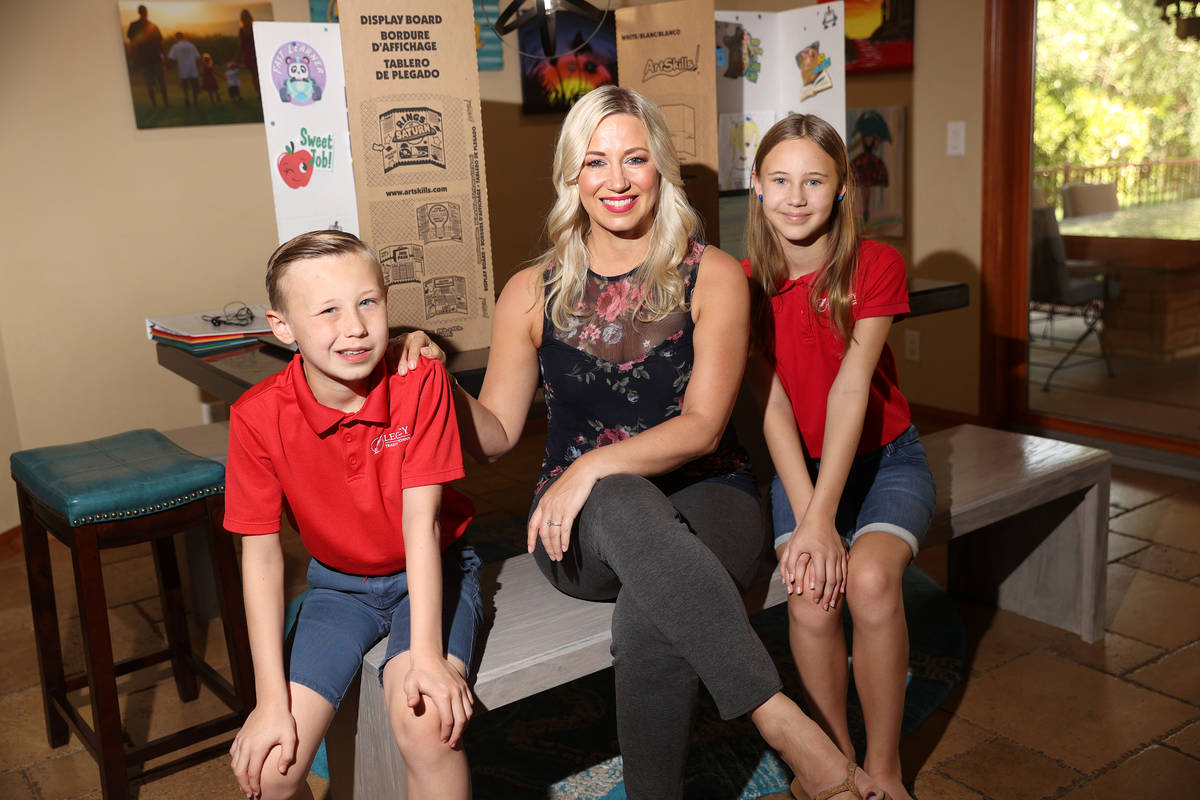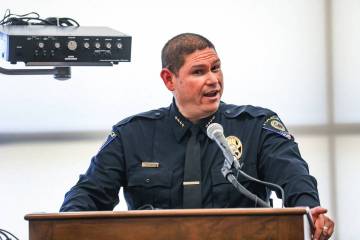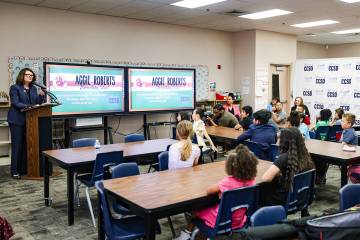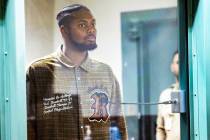An inside look at distance learning at one Las Vegas charter school
Levi Larrabee, a fourth grader at Legacy Traditional School, worked on a science assignment Tuesday in what looked like a makeshift office cubicle at the kitchen table as his sister, Lily, sat down to read, having completed her school work for the day.
As Levi logged on for his teacher’s live videoconference lesson at 1 p.m., his mother, Katy, reminded him to “put in your headphones so it doesn’t bother Lily.”
Levi, 9, couldn’t resist peering around the side of the repurposed tri-fold cardboard enclosure to see what his older sister, a fifth grader at the school, was doing.
So unfolded another day of distance learning in the Larrabee household.
Legacy Traditional School, a public tuition-free charter school with more than 4,500 students at three Las Vegas Valley campuses, began its school year Aug. 12 with distance education.
To get a better understanding of how the process works — and when it doesn’t — the Review-Journal joined the Larrabees on Tuesday afternoon at their home in southeast Las Vegas to get an inside look at distance learning in action.
Last month, the Nevada State Public Charter School Authority’s board issued a directive requiring schools in counties with an elevated level of COVID-19 transmission, including Clark County, to start the school year with distance learning for at least 75 percent of their student body. That includes Legacy, where the younger Larrabees attended the Cadence campus in Henderson before being exiled to the kitchen table.
The Clark County School District, with the exception of seven rural schools, is also conducting classes solely via distance learning to begin the school year began Aug. 24. But many Las Vegas Valley private schools are holding full-time in-person classes.
Jennifer Hackett, leadership coach for Legacy Traditional Schools Nevada, said Tuesday that distance learning hasn’t been as easy as Legacy school officials had hoped it would be.
“I think it is obviously new grounds for everybody,” she said, noting there is a learning curve that comes with that. But overall, she added, it has been “fairly successful.”
For the most part, families have been flexible and understanding, she said.
“We want our kids back in school,” said Hackett, who is anxiously awaiting when Clark County will be at baseline mitigation for COVID-19 transmission so the school can resume in-person classes.
Setting up a school space
Katy Larrabee, a Realtor for Coldwell Banker, was working Tuesday from a bar stool at a kitchen countertop while her children sat at the kitchen table.
“I’ve found it easier for them to be in the same room with me,” said Larrabee, whose eldest son, Seth, is a senior at Del Sol Academy of the Performing Arts.
Before COVID-19, Larrabee worked out of Coldwell Banker’s Green Valley office in Henderson. She said she misses being in the office and seeing her co-workers.
Some of her coworkers are still working from the office, she said, but noted those who have school-aged children are generally working from home.
But because Larrabee and her husband, Jesse, are both working, they have to coordinate their schedules to ensure that one or the other can be home to help the children with distance education. When Larrabee is out showing homes to clients, for example, her husband, an electrical contractor, stays home.
Initially, Katy Larrabee tried having Lily, 10, and Levi work from their bedrooms, but that was problematic when they needed help, and she found herself “running from room to room.”
She decided to move them to the kitchen table, but they started bugging each other, Larrabee said.
The solution: The tri-fold cardboard boards that work like blinkers on a racehorse to focus their attention and provide them with a semi-private workspace at the kitchen table.
“They made these partitions so we could concentrate a little bit more,” Larrabee said.
They each decorated their own board, which faces them when they’re working. “It’s kind of like a vision board,” Larrabee said.
Each board has their name, grade level, a printed-out image of Legacy’s Cadence campus logo, and other fun stickers and cutouts, including motivational messages. Levi’s board has a picture of a spaceship with the phrase “out of this world,” while Lily’s board has a picture with the message “Dive into a good book.”
Each child’s workstation includes a binder, a wireless computer mouse and a laptop computer.
Working out the kinks
Legacy is using an online learning management system called Schoology to run its program. Larrabee said Legacy held a virtual town hall meeting live on Facebook and recorded the video, which she watched twice before school started to get up to speed on the program.
Larrabee said her children have picked up on the technology quickly. “I think they know the technology side more than me.”
With the school now in its third week of distance learning, there has been an opportunity to work out some early kinks, Larrabee said.
On the first day of school, instruction couldn’t begin until 9 a.m. because of log-in issues with Schoology, said Hackett, the leadership coach.
In some cases, families weren’t logging into Schoology correctly, going to the platform’s website rather than accessing it through Legacy, Hackett said. There was also a technical issue, since fixed, where last year’s classes showed up in the program rather than the current students.
Larrabee said she thinks Schoology is a big improvement over the Google platforms the school used in the spring.
“It was just kind of tough and we were still printing packets for actual worksheets for them,” Hackett said, and parents were printing them out or picking them up at schools.
Larrabee said her children already each had a laptop computer, but Legacy distributed Chromebooks to children who needed one.
A typical day
On weekday mornings before school, Larrabee and the youngest kids go on a run or walk together to get exercise.
Then they follow a normal routine like they were going to school in person, including changing out of pajamas and brushing their teeth. “I think it helps to get them in the right mindset.”
Legacy students aren’t required to wear school uniforms while at home, but Lily and Levi both wore red polo shirts Tuesday with the Legacy logo on it. For footwear, both favored flip-flops.
A typical Legacy school day starts with a Facebook live school assembly, including a virtual Pledge of Allegiance.
Lily has live sessions at 9:30 a.m. and 1:30 p.m. Her teacher also has a 3 p.m. session where students can ask questions or get extra help.
Levi has live sessions at 9 a.m., 11 a.m. and 1 p.m. One of the morning sessions is for reading, Larrabee said. Levi chimed in “and sometimes grammar.”
“We fit lunch in there somewhere,” Larrabee said.
The minimum requirement for Legacy teachers is two 30-minute live sessions per day, Hackett said. “Some of our teachers are doing above and beyond that.”
Teachers are also available throughout the school day to answer student questions, she said, and are offering online tutoring sessions.
When Lily and Levi are participating in a live session, they either go into their room or plug in headphones if they’re working from the kitchen table.
“We just try to be fluid because every day is different,” Larrabee said.
She said she tries to keep each of them on the same day of instruction as their class, but sometimes they’ll work ahead. And sometimes when they’re antsy, Larrabee sends them outside to play for a bit.
Teachers are quick to respond when a student needs help, Larrabee said, noting she was surprised by the fast response time. “I don’t know how they’re doing it. It’s a tough time for them, too.”
Legacy teachers send out a schedule once a week mapping out each school day — when the live lessons are and what children should be working on at other times throughout the day, Larrabee said.
Families don’t have to follow that schedule — if parents are working during the day, for instance, and aren’t able to supervise distance education — but Larrabee said she follows it with her children to make things easier.
She said teachers let them know if the weekly schedule changes at all, noting “the communication has been amazing.”
Families can have their children do schoolwork on the weekends if that’s best with their schedule, Hackett said. Many families have multiple children and parents who are working, she added.
Live sessions are also recorded and posted in Schoology so students can watch later. And students have only one deadline — on Friday night — to turn in their assignments for the week.
Shortly after noon Tuesday, Lily was working on a math assignment, including fractions, multiplication, division and story problems. “I’m not happy about it,” she said.
A short while later, Lily got up and came over to her mother. “I finished math,” she said.
Larrabee responded: “Good job. Did you do it on paper?” Lily handed over the work she completed.
Levi was in the midst of his science studies.
For a while after that, the house was quiet except for the sound of typing, as the children worked on assignments on their laptops and Larrabee responded to emails.
Lily’s favorite subject is history and she’s an avid reader, Larrabee said. As for Levi, “he’s a math whiz,” she said. “He’s my little logical guy.”
Both Lily and Levi signed up for the Mozart track at school, but Larrabee said it’s a bummer they’re not able to have it in person.
From third through sixth grades, Legacy students can choose from two tracks for special classes: momentum fitness or Mozart performing arts. Students in the Mozart track have music four days a week and physical education once a week, and vice versa for the momentum track.
Larrabee said what her children miss most about in-person classes at school is seeing their friends. Lily turned around and nodded.
Larrabee said Lily and Levi work usually finish their schoolwork about the same time they would if they were attending school, around 2:45 p.m. Once they’re done with school, they go swimming in their backyard pool and enjoy family time.
Larrabee said one blessing in disguise about the COVID-19 situation is they have more time together as a family. And she said her children have taken on more responsibility around the house, such as helping with doing dishes and laundry. “They’ve grown a ton from this.”
Contact Julie Wootton-Greener at jgreener@reviewjournal.com or 702-387-2921. Follow @julieswootton on Twitter.



